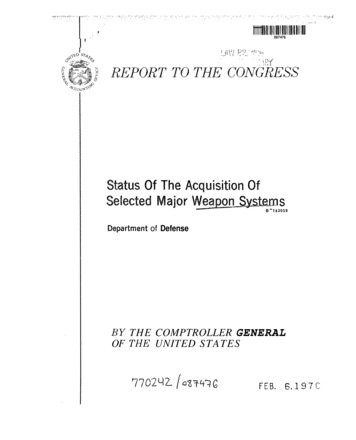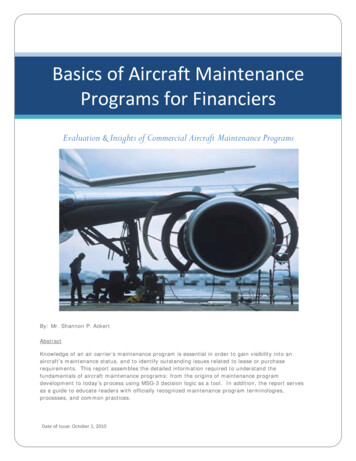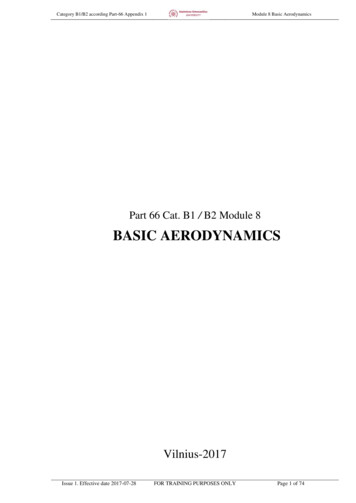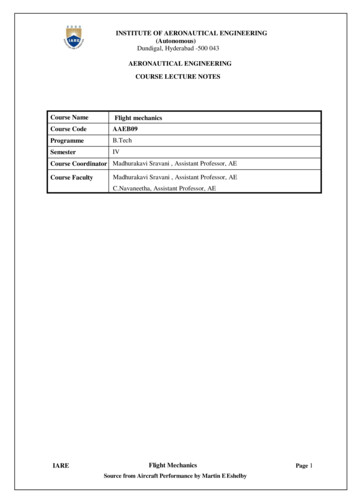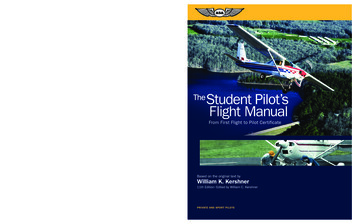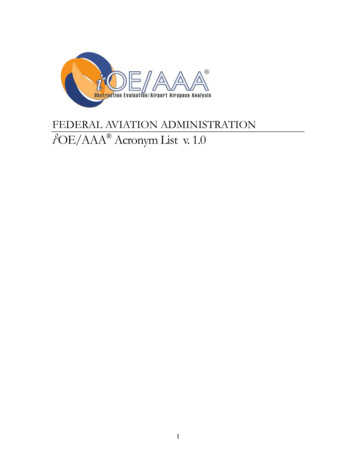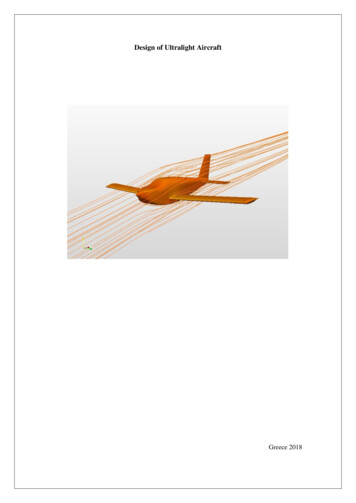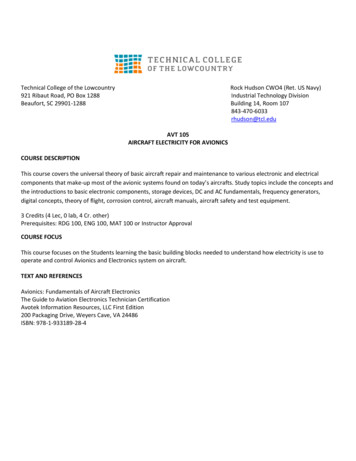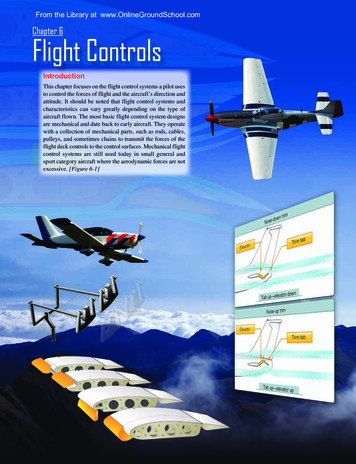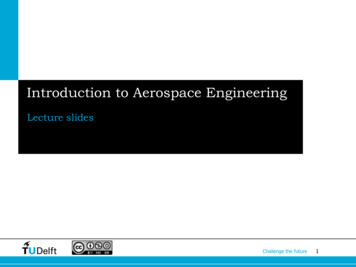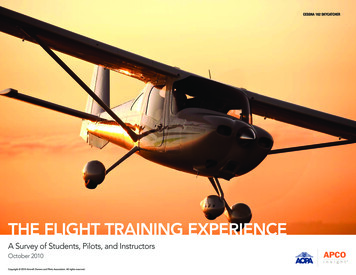
Transcription
CESSNA 162 SKYCATCHERA Survey of Students, Pilots, and InstructorsOctober 2010Copyright 2010 Aircraft Owners and Pilots Association. All rights reserved.
Background With more than 400,000 members, the Aircraft Owners and Pilots Association (AOPA) is the largest aviationassociation in the world. As a membership organization, AOPA offers a wide array of information andservices for pilots, prospective pilots, and aviation enthusiasts. As an advocacy group, AOPA works tirelesslyto preserve the freedom to fly. A key component of AOPA’s work is a dedication to growing the pilot population. Approximately 60 percentof those who earn a student pilot certificate never earn a higher pilot certificate (e.g., private, recreational, orsport). And many more drop out before ever obtaining a student pilot certificate—placing the overalldropout rate at an estimated 70 to 80 percent. Although AOPA’s Let’s Go Flying program is designed to encourage prospective pilots to begin flight training,AOPA felt it was time to take a closer look at ways to help those who have already begun training earn a pilotcertificate. These methods would complement the Flight Training magazine and website that currently servethe student pilot audience. There are many opinions about the state of flight training and how to improve it, but AOPA decided adeeper, more objective understanding of the flight training experience was critical to the success of anyefforts to improve student retention. As part of the AOPA Flight Training Student Retention Initiative, AOPAcommissioned an independent opinion research firm, APCO Insight , to model the optimal primary flighttraining experience and determine where the actual experience fails to live up to students’ expectations.GENERALAVIATIONAWARENESS2Copyright 2010 Aircraft Owners and Pilots Association. All rights IONPILOTRETENTION
Research ObjectiveBeyond CustomerSatisfactionWill better alignment withstudent expectations improvesuccess rates?This research program enabledkey audiences to define the optimaltraining experience and suggestalignment strategies.QUALITATIVE RESEARCHFocus groups with students, pilots, instructors, and flight school managers to create acomprehensive list of attributes associated with the optimal flight training experienceQUANTITATIVE RESEARCHA random-sample survey of students, pilots, and instructors to measure perceptionsof the attributes identified in the qualitative researchSTATISTICAL MODELINGA process designed to isolate the factors that describe the optimal flight trainingexperience, measure relationships between those factors, determine relative impact ofeach factor, and measure flight training providers’ performance on the factorsThe Flight Training Model3Copyright 2010 Aircraft Owners and Pilots Association. All rights reserved.
Research MethodologyQualitative Research Methodology The qualitative research focused on the shared set of experiences and challenges of all four groups. Recognizingthat each group has an important perspective on the same set of issues, focus group findings were important indeveloping an initial list of attributes to describe the optimal flight training experience.STUDENT PILOTS(CURRENT AND LAPSED)FLIGHT INSTRUCTORS(2) TWO-HOURFOCUS GROUPSWITH EACHAUDIENCE—ONEIN DALLAS ANDANOTHER INCHICAGOPILOTSFLIGHT SCHOOLOWNERS/MANAGERSQuantitative Research Methodology The quantitative research focused on testing the attributes to develop a comprehensive model. Three ofthe four groups were sampled in the survey (flight school owners/managers were not included because somehad not experienced primary flight training).SPECIFICATIONDESCRIPTIONDETAILSSample FrameAudience being surveyedStudents (Current and Lapsed),Pilots, InstructorsSample DesignSample SizeSampling ErrorConfidence IntervalData CollectionIncidenceSource of sample universeRandom sampleMargin of errorAttain margin of errorMode of conducting interviewsLevel of effort needed to reach eligible respondentsListed sample from FAA Database4Copyright 2010 Aircraft Owners and Pilots Association. All rights reserved.N 1,0003.0%95%Telephone and Online47%
Sample CharacteristicsPercentages are rounded to the nearest whole number. As a result, some groups may total more or less than 100%.5Copyright 2010 Aircraft Owners and Pilots Association. All rights reserved.
CIRRUS SR20 GTSThe Flight Training Environment6Copyright 2010 Aircraft Owners and Pilots Association. All rights reserved.
Flight Training Information SourcesInformation SourcesInternet/Online17%Friend/Family Member/Colleague16%Local Airport/Drove by the Airport16%School/Community College/Teacher15%Word of Mouth/Referral14%Contacted Local Flight School/Yellow Pages13%Pilots/Know a OPA/AOPA Magazines/AOPA Website4%Air Force/Military4%OtherNone**** The key information channelsare person-to-person Traditional advertisingvenues are still important:27 percent sought informationfrom ads The move to the Internet isalso apparent However, 57 percent* reportthey sought information onflight instruction from apersonal source12%1%Q1. When you decided to learn to fly, what sources of information did you rely on to find flight instruction?Open-ended question: Chart reflects multiple, verbatim responses therefore aggregate total will be more than 100%.7Copyright 2010 Aircraft Owners and Pilots Association. All rights reserved.
Primary Reason for Flight Training A large majority of pilots and students initially sought training for recreational reasons Only about one-third were primarily driven by business or professional interests Lapsed students are particularly focused on recreation Although all students must meet the same FAA Practical Test Standards, flight schools and instructorsshould adapt training approaches based on a student’s motivation (e.g., recreational versus professional)Primary Reason for Flight Training65%29%5%Recreational ReasonsLapsed StudentsFemalesPart 141 Students81%76%44%2%Business ReasonsCommercial PilotsProfessional Pilot Reasons8%Flight InstructorsCurrent StudentsOther50%25%STATISTICALLY SIGNIFICANT SUBGROUPS(Only groups with significant differences are shown)Q2. Did you seek flight training primarily for recreational reasons, business reasons, or to work professionally as a pilot?Percentages are rounded to the nearest whole number. As a result, some groups may total more or less than 100%.8Copyright 2010 Aircraft Owners and Pilots Association. All rights reserved.
Profiles of Flight Instruction Independent instructors are a common provider of flight training Only one in five attended a Part 141 flight schoolProfiles of Flight Instruction63%35%28%22%15%Independent InstructorOne InstructorThroughoutTraining41%Part 61 Flight SchoolMalesFlight Instructors29%38%Part 141 Flight SchoolOther/Something ElseFive or MoreInstructors DuringTrainingLapsed Students40%STATISTICALLY SIGNIFICANT SUBGROUPS(Only groups with significant differences are shown)D3. In your private pilot training experience, did you take lessons with an independent instructor, a Part 61 flightschool, a Part 141 flight school, or something else?9Copyright 2010 Aircraft Owners and Pilots Association. All rights reserved.Percentages are rounded to the nearest whole number. As a result, some groups may total more or less than 100%.24%
Strong Internet Usage Patterns Nearly two-thirds report they seek information about flight training from online sources Respondents report a diverse array of websites commonly visitedGet Flight Training Information OnlineWebsites Visited62%37%AOPA/AOPA Forums68%FAA/FAA Safety Website13%EAA12%AVwebOnline Flight PlannersTraining/Study/Student/Flight School (non-specific)YesMalesNo64%Lapsed %Aviation Weather2%OtherDon’t Know21%6%STATISTICALLY SIGNIFICANT SUBGROUPS(Only groups with significant differences are shown)D9. Do you regularly go to any websites toread about flying or flight training?10Copyright 2010 Aircraft Owners and Pilots Association. All rights reserved.D10. Which websites do you go to?Open-ended question: Chart reflects multiple, verbatim responses therefore aggregate total will be more than 100%.
A Strongly Positive ExperienceOverall Experience95% Clearly, the unique experienceof learning to fly is inherentlyrewarding to all audiencesSomewhat26%Very Nearly 70 percent report a“very good” experience Even lapsed students reporta favorable experience69%4%GoodCommercial PilotsCurrent StudentsFlight InstructorsLapsed Students1%3%Bad98%97%94%92%Lapsed StudentsFlight InstructorsCurrent StudentsCommercial Pilots7%5%3%2%Q3. And generally speaking, would you characterize the experienceyou had in primary flight training as very good, somewhat good,somewhat bad, or very bad?Percentages are rounded to the nearest whole number. As a result, some groups may total more or less than 100%.11Copyright 2010 Aircraft Owners and Pilots Association. All rights reserved. Notwithstanding the litanyof complaints heard in thefocus groups, the overallexperience of flight trainingcarries significant value andcan mitigate quality issues
Most Favorable Training ElementsCharacteristics of Primary Flight Training% Very GoodPeople at the school arefriendly and attentive71%The airplanes are readyto fly when scheduled68%My flight instructor isorganized and professional66%I can schedule lessons whenthey’re convenient to me65%My flight instructor is avery effective teacher64%I feel like I’m part of a specialaviation community61%I receive good value for my money61%Everyone at the school is seriouslycommitted to student success61%* Respondents report positiveexperiences for mostelements of their flighttraining experience The personal things* matter:Students report beingtreated well by flight schools* Focus groups suggestedthat exclusivity and inclusionin an achievement-orientedaviation community arepowerful themes*Q4. Here are some characteristics of primary flight training that you will probably remember. As I describe each one,please tell me if your experience was or has been very good, somewhat good, somewhat bad, or very bad.12Copyright 2010 Aircraft Owners and Pilots Association. All rights reserved.
Least Favorable Training ElementsCharacteristics of Primary Flight Training% Very GoodThe facilities are organized and useful55%The training aids are useful52%The school clearly explainedhow much training would cost52%The condition and appearanceof the airplanes are good50%I received important help inpreparing for my FAA written test50%The school clearly explained howmuch time it would take to finish49%Rates and prices are reasonable47% Although still favorable,respondents report lowersatisfaction with moremanagement-type elementsof the experience: What theschool is like and how clearlythey are explaining things Not surprisingly, informationand cost issues drop into lessthan 50 percent “very good”Q4. Here are some characteristics of primary flight training that you will probably remember. As I describe each one,please tell me if your experience was or has been very good, somewhat good, somewhat bad, or very bad.13Copyright 2010 Aircraft Owners and Pilots Association. All rights reserved.
Drivers of Positive ExperienceBeta CoefficientMy flight instructor is avery effective teacher0.302My flight instructor isorganized and professional0.226I receive good value for my money0.108People at the school arefriendly and attentive0.084Everyone at the school is seriouslycommitted to student success0.076The training aids are useful0.071I can schedule lessons whenthey’re convenient to me0.061 Regression analysis indicatesthat seven specific elementsare statistically predictiveof a positive flight trainingexperience It’s all about the instructor—it’s a decisive relationshipThe condition and appearanceof the airplanes are goodThe airplanes are ready to fly when scheduledThe facilities are organized and usefulRates and prices were reasonableI feel like I’m part of a specialaviation communityI received important help inpreparing for my FAA written testThe school clearly explained howmuch time it would take to finishThe school clearly explained howmuch training would costNot significant at the95% confidence level However, several elementsthat are functions of schoolmanagement also are keydrivers of the experienceDependent variable: Q3 (Flight School Favorability) / Independent variable: Q4 series (Flight School Charactersitics) R2 .50714Copyright 2010 Aircraft Owners and Pilots Association. All rights reserved.
Positive Aspects in Their WordsBest AspectsPositive AspectsEnjoyment of Flying/Being in the Air31%High-Quality Flight Instruction21%Learning How to Fly18%Building Confidence ThroughFlight Challenges and Achievement16%Flying Solo/Being Alone in the Air13%Being a Member of Aviation Community8%The Whole Experience4%Cross-Country se to Home3%Other11%Don’t Know*****1%Q5. Thinking about your flight training experience, what was the best aspect of it?Open-ended question: Chart reflects multiple, verbatim responses therefore aggregate total will be more than 100%.15Copyright 2010 Aircraft Owners and Pilots Association. All rights reserved. The sheer enjoyment of flyingis an important attribute thatshould be emphasized in flighttraining However, over half* ofthose surveyed cited an“achievement-oriented”attribute most favorably
Negative Aspects in Their WordsNegative AspectsCost/Expense/Finances/MoneyPoor or Unclear Instructions/Training20%17%Bad Weather8%Difficulty Learning How to Fly8%Scheduling/Time Conflicts/Instructor Availability7%Long Hours/Time Commitment6%Old Equipment/Poor Aircraft Quality5%Too Many Different Instructors4%Ground School/Bookwork3%FAA Regulations/Air Traffic Control2%Didn’t Finish2%NothingOtherDon’t Know Costs are a dominantconcern However, the quality ofinstruction is a persistentissue and a weak link inthe chain Scheduling issues andother delays also werecommon concerns16%9%1%Q6. And what was the most negative aspect of your flight training experience?Open-ended question: Chart reflects multiple, verbatim responses therefore aggregate total will be more than 100%.16Copyright 2010 Aircraft Owners and Pilots Association. All rights reserved.
DIAMOND DA20The Flight Training Model17Copyright 2010 Aircraft Owners and Pilots Association. All rights reserved.
Flight Training Model FactorsSecond-Order FactorsFirst-Order FactorsInstructor Support The qualitative research identified 67discrete attributes that described theoptimal flight training experienceEDUCATIONALQUALITY In the quantitative survey, respondentsrated the quality of their flight trainingexperience along all 67 attributes on a10-point scale Statistical analysis identified 47attributes that are decisive—correlating into 11 discrete firstorder factors (20 attributes fell fromthe model) Correlations between factor groupsdefined four broader themes (secondorder factors)Instructor EffectivenessOrganized LessonsTest PreparationAdditional ResourcesValueCUSTOMER FOCUSSchedulingQuality AircraftCOMMUNITYINFORMATION SHARINGAviation CommunityRecognitionInformation SharingOptimalFlight TrainingExperience18Copyright 2010 Aircraft Owners and Pilots Association. All rights reserved.
Flight Training Model AttributesCUSTOMER FOCUSEDUCATIONAL QUALITYInstructor Support Flight instructors maintain a professional demeanor Offers good compensation and benefits to instructors toencourage good performance Has more-experienced instructors occasionally ride alongto review your instructor’s teaching methods Flight instructors have effective teaching skills Follows a well-organized syllabus that clearly describeseach lesson Has well-qualified and experienced instructors Flight instructors are available between lessons to discussflight training Flight instructors demonstrate commitment to safety Establishes personalized lesson plans based on thestudent’s learning style Carefully interviews each student to help select the rightinstructor Flight instructors ensure students understand (and areprepared for) each lessonInstructor Effectiveness Flight instructors spend extra time with students toanswer questions Flight instructors demonstrate a commitment to studentsuccess at each stage of training Flight instructors review lessons with student before andafter each flight Plans each lesson carefully to make efficient use of timeand save money Seeks input from students about the quality of theirtraining experienceValue Offers good value and competitive pricing Offers discounts to encourage new pilots to seekadvanced ratings Avoids covering material in flight that could be coveredless expensively on the ground Provides practice written tests at no cost Guides students to free online learning resources Allows students to sit in the back for free during otherflight lessons to expand their learning Creates opportunities for low-cost group groundschool sessions Offers flight simulator time to students at low costSchedulingCOMMUNITYINFORMATION SHARINGAviation Community Makes students feel welcome in the aviation community Creates an atmosphere that makes students feel part ofsomething special Hosts events and parties for students and new pilots Has common area to socialize and learn from other pilotsRecognition Announces student milestones—like first solo flights—innewsletters and on school website Provides certificates for student achievements during thetraining process Hosts open houses and events recognizing studentmilestonesInformation Sharing Provides statistics on student success rates at the school Discloses the qualifications and experience level ofall instructors Shares student success stories and offers referencesfrom other students Provides realistic estimate of time and costs requiredfor a pilot certificate Keeps scheduling commitments made to the student Offers flexible scheduling to accommodatestudent’s schedule Schedules in advance to ease student’s planningQuality Aircraft Offers new pilots opportunities to fly moreadvanced aircraft Offers aircraft with modern equipment Keeps aircraft well maintained so they areavailable when neededSecond-Order FactorsFirst-Order FactorsInstructor SupportEDUCATIONALQUALITYInstructor EffectivenessOrganized LessonsTest PreparationAdditional ResourcesValueOrganized Lessons Varies flight routes and destination airports duringlessons Ensures that lessons are organized and that the studentisn’t rushedCUSTOMER FOCUSQuality AircraftTest Preparation Invites designated FAA examiners to meet with studentsthroughout the training process to get acquainted Prepares students to meet all Practical Test Standards fortheir checkrideAdditional Resources Provides doctor lists and guidance to help student obtaina medical certificate Directs students to online flight planners and other usefulwebsitesSchedulingCOMMUNITYINFORMATION SHARINGAviation CommunityRecognitionInformation SharingOptimalFlight TrainingExperience19Copyright 2010 Aircraft Owners and Pilots Association. All rights reserved.
FLIGHT DESIGN CTLSFactor Descriptions20Copyright 2010 Aircraft Owners and Pilots Association. All rights reserved.
Instructor SupportThis factor is about the flightschool, not the instructor.Schools must support and traintheir instructors, arrange agood student-instructor match,measure success, and ensurestandards of professionalismare met.SHARING21Copyright 2010 Aircraft Owners and Pilots Association. All rights reserved.
Instructor EffectivenessIt’s all about how the flightinstructors interact with theirstudents, including pre- and postflight briefings, and demonstratetheir commitment to studentsuccess.SHARING22Copyright 2010 Aircraft Owners and Pilots Association. All rights reserved.
Organized LessonsThis factor describes how eachlesson is organized to enhancestudent learning.Organized lessons keep traininginteresting, efficient, and don’trush the student.SHARING23Copyright 2010 Aircraft Owners and Pilots Association. All rights reserved.
Test PreparationMost students loathe both thewritten test and their checkride.This factor describes how schoolsease the process for checkridesby carefully preparing students.SHARING24Copyright 2010 Aircraft Owners and Pilots Association. All rights reserved.
Additional ResourcesStudents aren’t plugged intoresources that many pilots takefor granted.Directing students to otherresources and websites, andhelping them obtain their medicalcertificates is important.SHARING25Copyright 2010 Aircraft Owners and Pilots Association. All rights reserved.
ValueValue means far more than price.Schools should seek ways tostretch the student’s dollar,offer free or low-cost learningopportunities, and demonstratethey’re billing the student fairly.SHARING26Copyright 2010 Aircraft Owners and Pilots Association. All rights reserved.
SchedulingA key value proposition issimplifying the challenge studentshave in scheduling.Being flexible and schedulinglessons in advance really helps.SHARING27Copyright 2010 Aircraft Owners and Pilots Association. All rights reserved.
Quality AircraftStudents expect to train inclean, well-maintained, andreliable aircraft.They also want relatively modern,up-to-date equipment.SHARING28Copyright 2010 Aircraft Owners and Pilots Association. All rights reserved.
Aviation CommunityThere is great pride in beingadmitted to an aviation“community” that sharesa sense of accomplishment.SHARING29Copyright 2010 Aircraft Owners and Pilots Association. All rights reserved.
RecognitionStudents attach importance tohaving their accomplishmentsrecognized by others.Schools and instructors shouldfacilitate this recognition.SHARING30Copyright 2010 Aircraft Owners and Pilots Association. All rights reserved.
Information SharingStudents are at a knowledgedisadvantage and seek real-worldestimates of time and expenseinvolved in flight training.Students expect to seequalifications and the experiencesothers have had.SHARING31Copyright 2010 Aircraft Owners and Pilots Association. All rights reserved.
LIBERTY XL2Model Output32Copyright 2010 Aircraft Owners and Pilots Association. All rights reserved.
Output: Measures that MatterThe model provides three separate measurements that can be tracked over time:Impact Scores Measures the extent to which each factor drives the overall experience. These scores are presented in percentage terms to indicate the relativestrength of each factor.Performance Scores Depict how well the flight training experience performs along each of the11 first-order factors. The score is based on a scale from one to 10.Index An overall measure of the flight training experience that can beused for benchmarking purposes. The index is a number between 10 and 100 that takes into accountthe impact and performance scores of all of the factors.33Copyright 2010 Aircraft Owners and Pilots Association. All rights reserved.
Strengthsand WeaknessesStrengthsand WeaknessesIMPACT SCORE*INDEX SCORE: 64.1PERFORMANCE SCORE *Instructor SupportValueInstructor EffectivenessInformation SharingSchedulingAviation CommunityRecognitionOrganized LessonsTest PreparationQuality AircraftAdditional Resources*Relative strength of the factor in driving overall satisfaction.34Copyright 2010 Aircraft Owners and Pilots Association. All rights reserved.*Performance Score scale lines represent confidence interval of .169
StrengthsandWeaknessesFactor ImpactIMPACT SCORE*INDEX SCORE: 64.1Instructor SupportValueInstructor EffectivenessInformation SharingSchedulingAviation CommunityRecognitionPERFORMANCE SCORE * The most significant driver—“Instructor Support”—relatesto how well schools supportand manage their instructors. “Instructor Effectiveness”also is key: How well doinstructors do their job? Other expectations on“Value” (helping studentssave money) and“Information Sharing” (fulland realisitic disclosure)are high-impact.Organized LessonsTest PreparationQuality AircraftAdditional Resources*Relative strength of the factor in driving overall satisfaction.35Copyright 2010 Aircraft Owners and Pilots Association. All rights reserved.*Performance Score scale lines represent confidence interval of .169
StrengthsandWeaknessesFactor PerformanceIMPACT SCORE* Performance figures (howwell the factor describestheir experience) is thehighest among the higherimpact factors This is a good alignment thatsuggests the industry is playingto its strengths However, no performancescore goes much beyondthe scale midpoint, whichindicates a moderatelypositive alignment withtheir experiencesINDEX SCORE: 64.1PERFORMANCE SCORE *Instructor SupportValueInstructor EffectivenessInformation SharingSchedulingAviation CommunityRecognitionOrganized LessonsTest PreparationQuality AircraftAdditional Resources*Relative strength of the factor in driving overall satisfaction.36Copyright 2010 Aircraft Owners and Pilots Association. All rights reserved.*Performance Score scale lines represent confidence interval of .169
Reputation DriversReputation Driversfactorscomprising“EducationalQuality” drivenearlydrivehalf ofnearlythe overall f of the overallassessment of flight training.assessment of flight training. In effect, quality eclipses cost/value for most. It’s a challenge to the industry toIndemonstrateeffect, qualityeclipsesisprice/valuefor most; a challenge to the industry tothe experienceworth the price.demonstrate that the process is worth paying for.EducationalQualityEducational PilotsInstructors37Copyright 2010 Aircraft Owners and Pilots Association. All rights reserved.
lue(6.38, 14.2%)Instructor SupportIMPORTANTMORE IMPORTANTWEAKNESS(6.49, 14.9%)Instructor Effectiveness(6.50, 13.2%)InformationSharing(6.33, 8.0%)RecognitionAviation Community(6.20, 6.8%)(6.32, 7.5%)7.5%Organized Lessons(6.30, 5.3%)Quality Aircraft(6.33, 5.7%)Additional Resources(6.41, 6.1%)(6.31, 5.3%)LESS IMPORTANTSTRENGTHTest Preparation Play to strength ormitigate weakness? The flight trainingindustry is, in fact,doing wellPlayaligned;to strengthsor mitigateweaknesses?the important thingswell.SchedulingIMPORTANTLESS IMPORTANTWEAKNESSWEAKNESSMORE IMPORTANTSTRENGTHRelative Impact6.33Matrix The flight training industry Whereis the lowis well-aligned(doing thehangingfruitto well).importantthingsenhance student To enhance studentcommitment tocommitment, recall thecompletetraining?passion: “Recognition” on”obvious placesandwhereinitiatives can arebe undertaken.“Community”obvious placesRelative PerformanceMatrix depicts each factor’s performance and impact relative to the other factors.Matrix midpoints represent the median performance and impact score.Coordinates represent [Performance Score/Impact Score].38Copyright 2010 Aircraft Owners and Pilots Association. All rights reserved.where initiatives canbe undertaken.
8, MOREWEAKNESSWEAKNESSWEAKNESS(6.45, 6,(6.49, pport InformationInstructor(6.60,13.4%)(6.50, 13.2%)SharingInformation(6.78, 12.2%)SharingRecognition(6.30, .5%)7.5%RecognitionQuality AircraftAviation CommunityScheduling(6.54,6.2%)(6.47, 6.5%)(6.32, 7.5%)OrganizedLessonsTest PreparationTest Preparation(6.41, 6.1%)(6.28, 6.3%)(6.30, 5.3%)Organized LessonsAdditional ResourcesQuality Aircraft(6.58, 5.2%)(6.49, 5.6%)(6.33, 5.7%)Additional Resources AKNESSWEAKNESSWEAKNESSWEAKNESS(6.20, 6.8%)(6.31, THSTRENGTHSTRENGTHRelative ImpactValueRelative PerformanceMatrix depictsdepictseacheachfactor’sfactor’simpact andandperformancerelativethe otherfactors. Matrix midpointsMatrixperformanceimpact relativeto thetootherfactors.representthe medianimpactand performancescore.Matrixmidpointsrepresentthe medianperformanceand impact score.Coordinates represent [Performance Score/Impact Score].Coordinates represent [Impact Score/Performance Score].39Copyright 2010 Aircraft Owners and Pilots Association. All rights reserved. PlayPlay toto strengthstrength orormitigateweakness?mitigate weakness?“Value”slipsinto thThe flighttrainingindustry is, in fact,“importantwellaligned;doing weakness”“Value”slipsinto thequadranthe “Importantimportant thingsforstudents. Weakness”quadrant for studentswell.“Community” is alsoWhereis the low- is more more“Community”important alsoforhangingfruitfortostudents, evenimportantstudentsevenas thenhancestudentas the industry’sindustry’sperformancetois weakcommitmentperformanceiscomplete training? Core strengths remainweak.Recallthe passion:“EducationalQuality,” rengthsand“Community”remainqualityareobvious placeseducationandwhere initiatives caninformationsharingbe undertaken.
FlightTrainingMessageLapsedStudentsvs. PilotsLapsedStudentsv. PilotsLapsed Students v. PilotsMatMORE IMPORTANTIMPORTANTWEAKNESS Scheduling is also an area of poor performance for lapsed students.(6.50, 13.2%)* See “A Strongly Positive Experience” (Page 11)(6.39, 8.0%)(6.39, 8.0%)(6.25, 5.3%)(6.25, 5.3%)(6.19, 3.7%)(6.19, 3.7%)RelativeRelative PerformancePerformanceCopyright
the student pilot audience. There are many opinions about the state of flight training and how to improve it, but AOPA decided a deeper, more objective understanding of the flight training experience was critical to the success of any efforts to improve student retention. As part of the AOPA Flight
